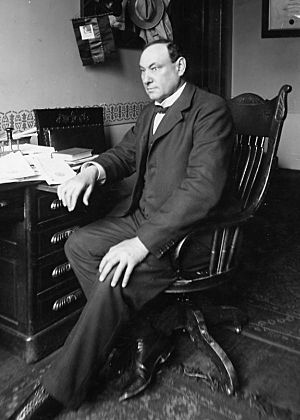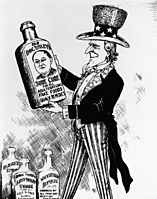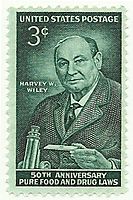Harvey Washington Wiley facts for kids
Quick facts for kids
Harvey Washington Wiley
|
|
|---|---|
 |
|
| Born | October 18, 1844 Kent, Indiana, United States
|
| Died | June 30, 1930 (aged 85) Washington, D.C., United States
|
| Resting place | Arlington National Cemetery |
| Alma mater |
|
| Occupation |
|
| Years active | 1882–1930 |
| Known for |
|
| Spouse(s) | Anna Kelton |
| Parent(s) |
|
| Awards | Elliott Cresson Medal (1910) |
| Signature | |
 |
|
Harvey Washington Wiley (October 18, 1844 – June 30, 1930) was an American chemist who fought for the passage of the landmark Pure Food and Drug Act of 1906 and subsequently worked at the Good Housekeeping Institute laboratories. He was the first commissioner of the United States Food and Drug Administration. Wiley was elected as a member to the American Philosophical Society in 1904. He was awarded the Elliott Cresson Medal of the Franklin Institute in 1910.
Early life and career
Wiley was born on October 18, 1844 in a log farmhouse near Kent, in Jefferson County, Indiana, the son of a farmer. He enrolled in nearby Hanover College in 1863 and studied for about one year until patriotism inspired him to enlist with the Union Army in 1864 as a corporal in Company I of the 137th Regiment Indiana Volunteers during the American Civil War. He returned to Hanover in 1865 where he majored in the humanities and was a top graduate (A.B.) in 1867. He received an A.M. there in 1870. Wiley studied at Indiana Medical College where he received his M.D. in 1871. He was professor of Greek and Latin at Butler College, Indianapolis, 1868-70.
After he graduated, Wiley accepted a position teaching chemistry at the medical college, where he taught Indiana's first laboratory course in chemistry beginning in 1873. Following a brief interlude at Harvard University, where he was awarded a B.S. degree in 1873 after only a few months of intense effort, he accepted a faculty position in chemistry at the newly opened Purdue University in 1874. He was also appointed state chemist of Indiana.
In 1878, Wiley travelled overseas where he attended the lectures of August Wilhelm von Hofmann — the celebrated German discoverer of several organic tar derivatives, including aniline. While in Germany, Wiley was elected to the prestigious German Chemical Society founded by Hofmann. Wiley spent most of his time in the Imperial Food Laboratory in Bismarck working with Eugene Sell, mastering the use of the polariscope and studying sugar chemistry. Upon his return to Purdue, Wiley was asked by the Indiana State Board of Health to analyze the sugars and syrups on sale in the state to detect any adulteration. He spent his last years at Purdue studying sorghum culture and sugar chemistry, hoping, as did others, to help the United States develop a strong domestic sugar industry. His first published paper in 1881 discussed the adulteration of sugar with glucose.
Work at Good Housekeeping
After his resignation from government work in 1912, Wiley took over the laboratories of Good Housekeeping Magazine, where he continued his work on behalf of the consuming public.
He remained with Good Housekeeping for 18 years.
Death
Harvey Wiley died at his home in Washington, D.C. on June 30, 1930, the 24th anniversary of the signing of the Pure Food and Drug law. He is buried in Arlington National Cemetery with his wife Anna Kelton Wiley (1877–1964) whom he married in 1911.
Legacy
Harvey W. Wiley has been honored in a number of ways since his passing:
The Liberty Ship S.S. Harvey W. Wiley was one of 2751 World War II Liberty Ships built between 1941 and 1945. She was a tanker laid down September 15, 1943, launched October 15, 1943, sold by the government in 1947, and scrapped in 1969.
The U.S. Post Office issued a 3 cent postage stamp in Wiley's honor on June 27, 1956, in conjunction with the 50th anniversary of the 1906 Act.
The Harvey W. Wiley Award is AOAC International's most prestigious scientific award established in 1956 and presented annually since 1957 to a scientist (or group of scientists) who have made an outstanding contribution to analytical method development in an area of interest to AOAC International. AOAC International was founded in 1884 as the Association of Official Agricultural Chemists. Wiley as a founding member, President in 1886, Secretary from 1889 to 1912, and Honorary President until his death in 1930.
Wiley has several buildings named in his honor. Wiley was honored by Hanover College with a "Wiley Residence Hall" inaugurated in 1956. He was also honored by Purdue University in 1958 when the "Harvey W. Wiley Residence Hall" was opened northwest of the main academic campus. The FDA's Center for Food Safety and Applied Nutrition (CFSAN) operations are located in the Harvey W. Wiley Federal Building in College Park, MD, constructed in 2001, and named after Wiley in 2002.
His birthplace near Kent is commemorated with an Indiana historic marker sign placed at the corner of IN-256 & CR-850W. The marker was sponsored by the Association of Food and Drug Officials and erected in 1981.
The French government named him a Chevalier of the Order of the Légion d'honneur in 1909.
The Harvey Washington Wiley Distinguished Professor of Chemistry is an honor established through the Chemistry department at Purdue University. The position has been occupied since 1997 by Dr. Dale W. Margerum.
The home he built at Somerset, Maryland in 1893, the Wiley-Ringland House, was listed on the National Register of Historic Places in 2000.
- Depictions of Harvey W. Wiley and advocation for the U.S. Pure Food and Drug Laws
-
Commemorative 50th Anniversary of Pure Food and Drug Laws stamp first issued by the U.S. Postal Service on June 27, 1956
Images for kids







